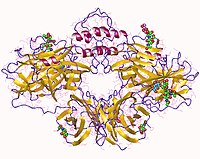
Photo from wikipedia
Pyridinones have been adopted as an important block in medicinal chemistry that could serve as hydrogen bond donors and acceptors. With the help of feasible synthesis routes via established condensation… Click to show full abstract
Pyridinones have been adopted as an important block in medicinal chemistry that could serve as hydrogen bond donors and acceptors. With the help of feasible synthesis routes via established condensation reactions, the physicochemical properties of such a scaffold could be manipulated by adjustment of polarity, lipophilicity, and hydrogen bonding, and eventually lead to its wide application in fragment-based drug design, biomolecular mimetics, and kinase hinge-binding motifs. In addition, most pyridinone derivatives exhibit various biological activities ranging from antitumor, antimicrobial, anti-inflammatory, and anticoagulant to cardiotonic effects. This review focuses on recent contributions of pyridinone cores to medicinal chemistry, and addresses the structural features and structure–activity relationships (SARs) of each drug-like molecule. These advancements contribute to an in-depth understanding of the potential of this biologically enriched scaffold and expedite the development of its new applications in drug discovery.
Journal Title: Frontiers in Chemistry
Year Published: 2022
Link to full text (if available)
Share on Social Media: Sign Up to like & get
recommendations!